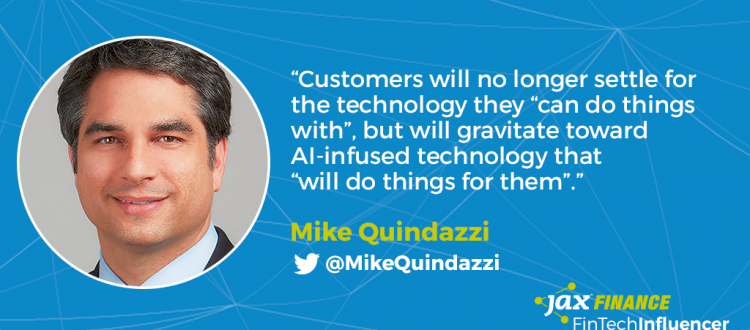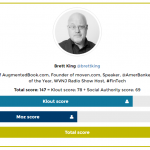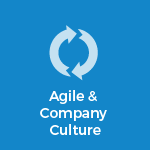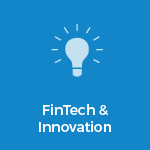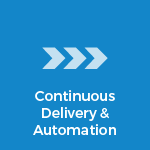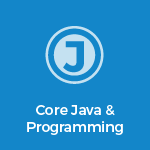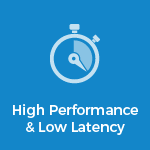JAX Finance: What got you interested in FinTech?
Mike Quindazzi:
Early in my career, I had the opportunity to work on a number of what I would call today old school projects. While the hashtag #FinTech was not yet invented, and yes the technology was primarily mainframes and terminals, all of the projects had an important financial services technology component that drove significant ROI.
On one initiative, we looked at further automating the batch collection and remittance of client payroll taxes across every taxing jurisdiction in the US. On another, we leveraged the Automated Clearing House (ACH) to process large volumes of transactions and automatically collect customer invoice payments. On a third, we worked on a direct deposit to pay card solution specifically to help address the unbanked employee.
These experiences in my younger days helped me quickly realize the impact and high potential of financial service technology, not only in the industry but in others as well. The pay card project, in particular, highlighted the need for and potential economic gain from broader financial inclusion.
As my career progressed over the next few decades, I continued to build on my early experience by leveraging new and emerging technologies. Today, I find great satisfaction working with my clients, both large enterprises and venture-backed startups, with both strategy and complex systems integration.
JAX Finance: Do you think the phrase “evolve or die” describes banks’ situation right now?
Quindazzi:
Putting aside FinTech for a moment, there has always been challenges in the industry, and today it is no different. Let me share a sample of today’s challenges needed to be mastered for institutions to operate effectively in tomorrow’s financial services market.
Certainly Brexit will impact US banks in a number of ways:
- If they subject to the legal, regulatory, tax environment in the UK,
- if they have a reliance on movement of goods and services between the UK and the EU, and
- if their business depends on the free movement of people between the UK and the EU. Banks are seemingly aware of these issues and should plan to be ready for when Prime Minister May invokes Article 50, the two-year process by which a state must leave the EU.
In the US, President Trump issued an executive order on February 3 asking the Secretary of the Treasury to review the Dodd-Frank Wall Street Reform and Consumer Protection Act of 2008 (Dodd-Frank) and report back to the President within 120 days of the executive order. He also signed another order requiring that two existing regulations be repealed for every new regulation issued. This changing regulatory environment comes at a time when the industry is transforming around new risk management cultures and ethics while rebuilding public trust and often playing defense.
Today’s competitive and economic backdrop continues to change. Banks, asset managers, wealth advisors and insurance companies once competed only in their silos. While they still do today, they also face competition from non-traditional market players with new skills, funding sources, and approaches. In the prolonged low-interest rate environment, many have been driven to use cost containment as the key to success in a more complex regulatory environment. Others are scrambling for top line growth (both organically and through acquisition) in a search for new revenue opportunities.
Getting back to technology, the nature of the FinTech narrative over the past few years has been evolving. As well, the pace of technology change continues to accelerate. Rapidly evolving advances in artificial intelligence across chatbots, robo-advisors, claims, underwriting, IoT and soon blockchain, add another layer of potential to further shake-up the traditional business model.
These advances and others are further fueling concerns about FinTechs eating away at profitable customers and stealing away a generation of millennials. So, depending on where you sit in the ecosystem, these innovations are either downright unsettling or highly aspirational. Yet with all this discussion, we are starting to see clear strategies and paths forward in our new digital world.
Rapidly evolving advances in artificial intelligence across chatbots, -advisors, claims, underwriting, IoT and soon blockchain, add another layer of potential to further shake-up the traditional business model.
At first, many of the startups said they were coming to eat the incumbent’s lunch, now they’re asking them out to lunch. And for good reason. Our clients are quickly realizing the value and position of incumbents in providing the distribution, while the FinTech innovators are developing solutions across sectors and use cases. Our PwC DeNovo team is doing the matchmaking, bring the sides together, and helping clients realize the synergies.
JAX Finance: Does FinTech still deserve the label “disruptive” or has it outshined this tag?
Quindazzi:
OK, let’s talk FinTech disruption, a new-old idea but one that as I mentioned is accelerating! And yes, since the first microprocessors of the 1960’s, technology innovation has been fundamental to transformation in the financial services industry.
In 2017, new technologies (fueled by another strong year of venture capital and corporate investment in 2016; plus greater connectivity, clouds, storage, APIs, and computational power) are very much poised to drive the next wave of financial services innovation. We are seeing record numbers of startups and legacy financial services companies both searching to acquire and serve the customer more empathically.
Yes, the customer is king in 2017, growing both in size and numbers. We are seeing an emerging middle-class rise-up in leading emerging markets, yet, 42% of the global adult population is still absent from the formal financial system and all the opportunities provided by financial services.
The un(der)banked appear to be FinTech’s largest global opportunity.
To further the point, the un(der)banked appear to be FinTech’s largest global opportunity. Mobile money services have already proven to be an effective gateway for financial inclusion among the un(der)banked, yet this demographic that could evolve into a US$3 trillion payments volume opportunity. Additionally, our team sees US$360 billion in unmet banking deposit demand, with insurance facing more than US$20 billion in un-captured premiums in the U.S. market alone.
While the mobile phone has been the enabling technology, and money services the entry point for the un(der)banked, access, trust, and tapping into evolving consumer expectations will drive the sustainable conversion of this demographic to the formal financial system.
JAX Finance: What are the biggest (and most important) trends in FinTech right now?
Quindazzi:
While many legacy industries are finally making progress with digital transformation, financial services is further down the road on the digital agenda. The difference, today, is the speed and extent of the transition and the acceleration of FinTech.
Artificial intelligence is showing the potential of intelligently automating more and more of the business, from customer service to investment advice. This trend will continue to evolve, both for internal processes and external tasks involving customer acquisition. We are seeing new data sources being analyzed by more advanced machine learning algorithms, providing new insights from players coming out of left field. The number of chatbots, virtual assistant + skills, and more intuitive mobile-apps/digital interfaces are rising at an exponential rate.
Customers will no longer settle for the technology they “can do things with”, but will gravitate toward AI-infused technology that “will do things for them”. Design around the user interface and overall user experience will continue to serve as a new area where financial services will find competitive advantage. FinTechs in other regions will continue to take a page from the Silicon Dragons in China by further integrating FinTech with mainstream social media and messaging apps.
Another area that is clearly appealing is digital labor, which includes robotic process automation (RPA) and intelligent process automation (IPA). While on-boarding digital labor in the past has created stumbling blocks for financial services, new tools and advances in RPA are providing the opportunity to automate a wide range of activity without the need for complex programming. 2017 is a new start to deliver efficiencies, reduced headcount, and find quicker payback on RPA investments.
As more sensitive data moves to the cloud, financial institutions will need to improve cybersecurity against new threat vectors. 51% of US financial services respondents in the 2017 PwC GSIS survey reported that they use managed security services for solutions like authentication and real-time monitoring and analytics. It’s time for institutions to start considering an integrate cybersecurity, anti-fraud, and anti-money laundering effort as a competitive advantage.
Institutions can look to ward off cyber-threats by combining analytics from pooled data, strengthening the risk management environment, and implementing controls more effectively. Also, by integrating cybersecurity and privacy in the beginning stages of a FinTech project, they can avoid costly breaches and remediation.
Customers will no longer settle for the technology they “can do things with”, but will gravitate toward AI-infused technology that “will do things for them”.
JAX Finance: Do you think the investment potential will attract entrepreneurs to FinTech?
Quindazzi:
It’s impossible to predict the future, but there are a few interesting indicators. In 2016 the capital markets experienced a few ups and downs. The IPO market slowed while investments and startup valuations continued to build. In 2017, the US stock markets have picked-up. Startups are staging at a greater rate to go public, yet many are dual-tracking and planning for other exit strategies. So it appears like the market is robust for entrepreneurs looking to grow with a company.
For new upstarts, the equation also seems positive but maybe riskier for entrepreneurs. Today, startups have access to free open source software, growing amounts of data, robust APIs, scalable cloud computing and source development needs on-demand and from low-cost markets. So now the technology barrier-to-entry has dropped, and the door is wide opened for entrepreneurs to develop solutions with a limited need for upfront capital.
Need more enticement? FinTech startups have the ability to innovate quickly without the encumbrance of legacy costs, infrastructure or the risk adverse culture found in legacy players.
So what’s the catch? It’s a very competitive world. New ventures are being started every day looking to attract the best people and the smartest money. Venture capital is looking for unique companies with new and differentiated services that previously have not existed. If multiple companies are working on parallel ideas, it’s a race to relevance for the entrepreneurs.
Startups must be able to evolve from early-stage to later-stage companies. Often this takes years (sometimes a decade or more) and a collection of talented people and savvy backers. Strong leadership is required to guide an organization of idea generators/developers to a team great business manage while moving from controlled chaos to structured process, all while continuing the entrepreneurial sprint.
JAX Finance: How important is blockchain in this equation? Can FinTech help it go mainstream?
Quindazzi:
Blockchain is no longer just about bitcoin or the broader category of cryptocurrency; it’s about the underlying technology. It’s unique and differentiated in that it’s immutable ledger with a single version of the truth of the transaction. And unlike other immutable datastores, it is also a shared or distributed ledger across a peer-2-peer private or public network.
By the 2020s, PwC expects that blockchain-based systems will be used by leading enterprises to reduce or eliminate categories of validation and verification friction for simple transactions. Moreover, these simple transactions will become the basis for smart contracts, a promise to automate processes and make them legally binding and self-enforcing at the same time.
As of the beginning of 2017, Venture Scanner was tracking 875 blockchain and bitcoin technology companies across 12 categories, and popping up in 73 countries, with a total of $1.8 billion in funding.
More specifically, the PwC DeNovo team found the blockchain ecosystem is evolving quickly with several consortiums driving proofs of concepts, and several startups focusing on different aspects of the market. The DeNovo team is following 158 blockchain-specific companies across 24 industry sub-sectors, illustrating the wide-ranging and flexible nature of the technology. What’s interesting about these numbers is they are all pure-play blockchain companies in the financial services industry, and it excludes cryptocurrency and exchange companies.
These startups are positioned to help build-out blockchain ecosystems which will require four layers of technology including;
- application,
- application development and APIs,
- protocol/ business logic, and
- distributed messaging.
Associated with this distributed ledger stack, are hosted services that encompass all aspects of the technology in the cloud. This type of cloud computing environment enables startups to enter the fray as blockchain still requires further experimentation and development.
There are two limiting factors with the bitcoin model that need attention for blockchain to go mainstream. First, unaffiliated miners are unlikely to be viewed as an accepted participant by regulators or banks. Second, transaction throughput is technologically limited and needs to increase exponentially to challenge the legacy systems.
JAX Finance: What does innovation mean to you?
Quindazzi:
Innovation is about adding things together or taking parts away to create a new offering with a higher value than when you started. It should be a straightforward as “adding” one-click borrowing button with all the automation to gather and process the loan documentation in the background. For innovations to have a chance at life, a company’s innovation strategy needs to support the overall business strategy and objectives. Innovations will succeed past the concept stage if they can be linked to business results, such as acquiring new customers, lowering costs, and growing revenues.
Innovation can be approached in three ways:
First, you might be looking for small changes to a process or product that can be characterized as better, faster, cheaper and with a normalized revenue growth. This path clearly has the lowest risk regarding cost outlay and disruption to the business.
Second, is when a company is looking for a breakthrough or a significant change to the technologies or business model of a product or service that creates significant new competitive advantages and drives higher revenue growth. This approach has increased risk but given a higher potential return.
The third is more of a radical approach including substantial changes to technology and business model. The goal is to create a new basis of competition in existing markets (such as new technology platform or cost basis) or creates entirely new markets that provide customers with new value.
Success comes from finding the mix of innovation types to achieve strategic objectives include the expected ROI from a pool of R&D spending.
JAX Finance: What does the future of finance look like?
Quindazzi:
In 2017, 1.5 million people around the world will be added to our city populations. By 2050, nearly 70% of the world’s population will live in urban areas, fueling a rising middle class. To put this in context, this is an increase from only 18% in 1950 and 50% in 2014.
By 2020, nearly ½ of the world’s population will be digital natives, many growing up not knowing a world without the internet. Smartphone subscriptions will grow from 2.6 billion at the start of 2016 to nearly 5.8 billion in 2020, reports GSMA. New consumers will have new expectations for digital on-demand financial service; they will look for competitive solutions and broader financial inclusion.
Already, we have mobile money services available in 90 emerging market to over 1.9 billion people globally; this number may double in the next five years. Once connected, financial institutions will have the opportunity to build trust further and offer customers the range of legacy services including banking, lending, insurance, and investments but delivered in new and more seamless ways.
Leading financial institutions will further embrace a digital-customer-regulator-centric world to shape their future and prosper. This focus needs to happen all while the world is redefining the nature of currency, business operating models are transforming, and cybercrime is becoming a major risk category.
These leaders will mostly likely tackle these challenges by creating a purpose-driven mission, embracing the power of emerging technology, building on the goals of regulation, finding the creativity of people and delivering on the value of their brand to build trust in the digital world.

